The Met Readies to Reveal ‘Kimono Style’ Exhibition

However little or much you think you know about kimonos is surely likely to change after seeing “Kimono Style: The John C. Weber Collection” at the Metropolitan Museum of Art.
Opening to the public Tuesday, the exhibition highlights the artistic exchanges between the kimono and Western fashion through 60-plus examples of the T-shaped Japanese garments, as well as through Western couture, textiles, Japanese paintings, prints and decorative art objects. Just as collaborations reign supreme in fashion, so do they in the museum, as evidenced by the numerous entities — including the Costume Institute, the Departments of Asian Art, Textile Conservation and Scientific Research, among others — that worked together to coordinate the show.
More from WWD
A Closer Look at Yeezy Gap Engineered by Balenciaga's Second Drop
Louis Vuitton, Burberry, Thom Browne, Ralph Lauren, Moschino and Gucci Reigned at the 2022 Met Gala
“’Kimono Style’ brings to light “the art of the kimono from a transnational perspective, highlighting the artistic conversations between Japan and the West, and the garment’s continued impact on designer’s around the world,” said Max Holbein, The Met’s Marina Kellen French director. It also celebrates the promised gift of 40 modern kimonos to the museum from the established collector of Japanese art John C. Weber. One defining element of Weber’s collection is the range of “meisen” kimonos, affordable ready-to-wear styles that took hold in the 1920s and drew from Western art. The show also highlights how the transformation of kimonos depicts women’s history and lifestyle, which was not recorded in books during the Edo period (1615 to 1868).
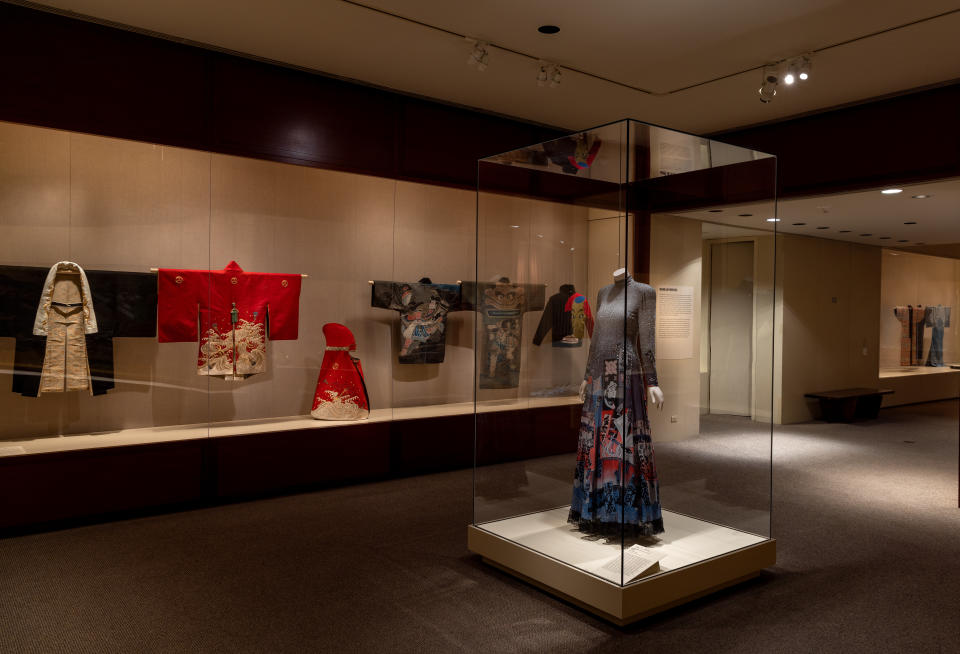
Photo by Barry Schwarz/Courtesy The Met
Japan’s signature weaving, dyeing and embroidery techniques reached their peak of artistic sophistication in that time. Fashion, however, was not then a free choice, due to the military government’s control of society. The use of gold in attire and other pricey techniques were regulated by the Tokugawa shogunate. The samurai topped the social hierarchy, whereas commoners had three levels — farmers, artisans and merchants.
Ruling members of the military class weren’t the only ones selecting intricate kimonos — the merchant class sported them as status symbols. Stretching across 10 galleries, the exhibition highlights how kimonos evolved including during the Meiji period when Western clothing was introduced to Japan.
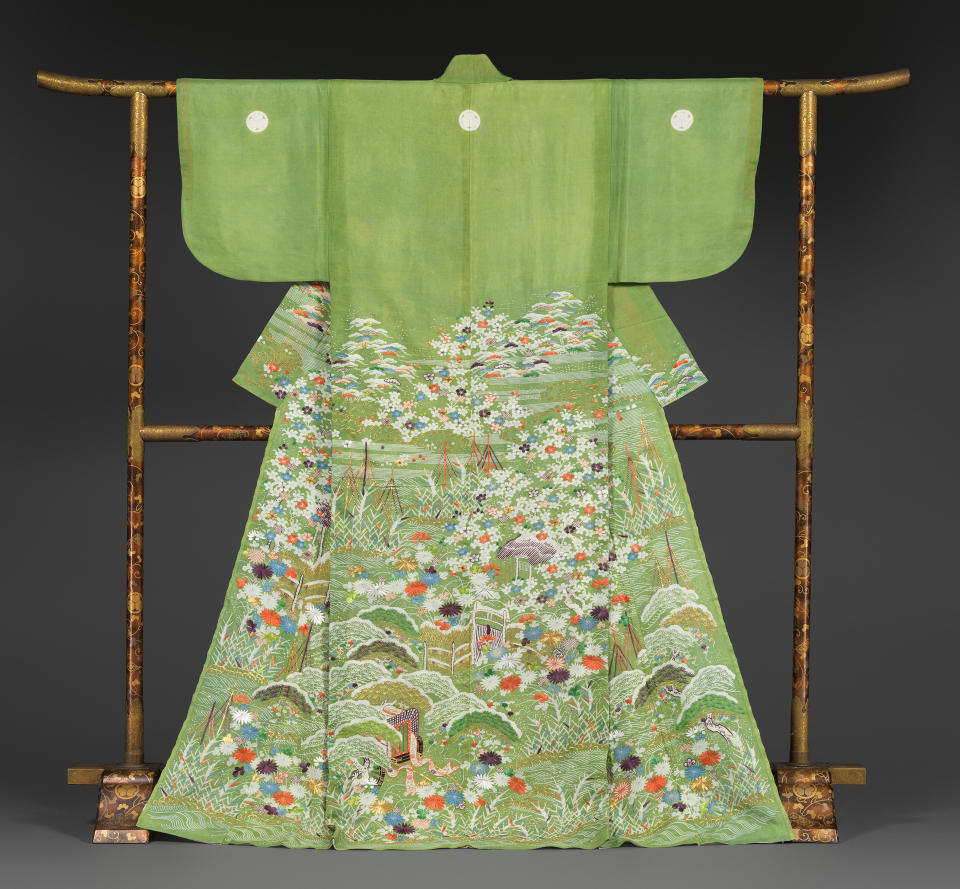
Photo by Paul Lachenauer/ Courtesy Metropolitan Museum of Art
During a preview Friday, Mónika Bincsik, the Diane and Arthur Abbey associate curator for Japanese Decorative Arts, said one of the takeaways is that “the Japanese kimono is fashion. We sometimes think of these beautiful garments as art, which is true, because they are beautifully made. But also, Japan had a fashion system going back to the 17th century. It isn’t widely known in the West that they were promoting trends, fashionable patterns and colors. If you had a kimono for five or 10 years, it went out of fashion. You needed new ones if you were a high-ranking samurai lady or a wealthy merchant lady.”
Whiile Issey Miyake and Yohji Yamamoto are a few of the international designers inspired by the kimono, the garment’s influence on Western fashion dates back to the 16th century, when Portuguese travelers arrived in Japan and brought back kimonos to Europe, she said. That led to kimono-inspired morning gowns being made, according to Bincsik, who co-curated “Kimono Style” with Karen Van Godtsenhoven.
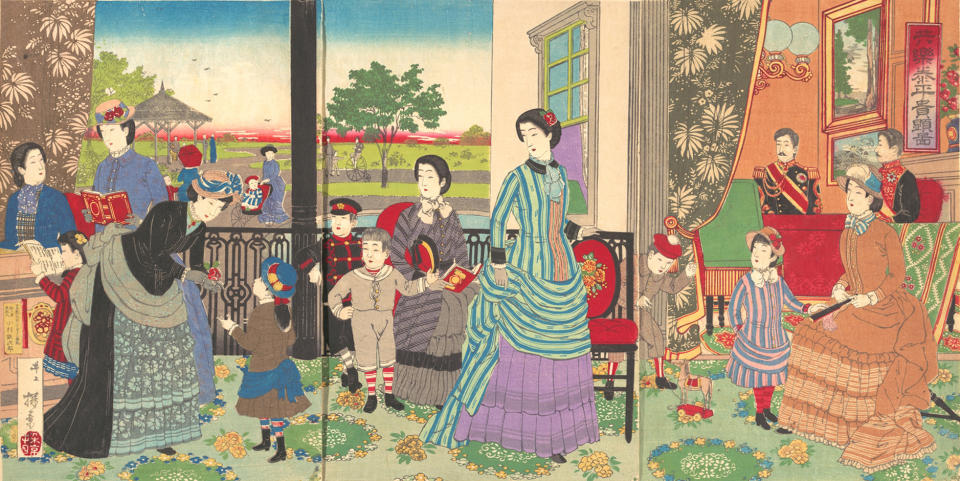
Image courtesy The Metropolitan Museum of Art
Over time the Japanese used European wool to make garments and learned such European techniques as producing inexpensive silk, which revolutionized the production of silk kimonos for women at the beginning of the 20th century. European intellectuals were among the first to popularize the loose-fitting, warm and padded garments. Visitors will see numerous examples of how the kimono has been a catalyst to inspire new motifs and silhouettes from such designers as Madeleine Vionnet, Paul Poiret, Cristóbal Balanciaga, Thom Browne, Hanae Mori, Comme des Garçons and John Galliano for Maison Margiela. One anchor piece is a 1919 “Paris” coat that was made by Poiret using a single 15-foot piece of silk velvet that required minimal cutting, similar to the kimono. Counter to the hourglass silhouette that was popular at that time, Poiret liberated women from the corset, Bincsik said. “The kimono was a very important part of a new avant-garde couture developing in France in the early 20th century,” she said.
On view are kimonos from the late 18th through the early 20th centuries, but the lasting influence can still be seen today in fashion, thanks to contemporary kimono designers inspired by Western ideals and styles, Bincsik said. Younger ones incorporate denim or streetwear elements and designers in the West remain deeply influenced by the silhouette or the idea of kimonos.
The lavender backdrop and graphic oversized lettering of “Kimono Style” above the entrance to the exhibition in the Arts of Japan galleries hints at its modernity and relevance. The first section showcases theatrical costumes that preserved ancient traditions in medieval times. Samurai and aristocrats sponsored Noh actors and in appreciation they gave their garments to actors. Later on, those aristocratic garments were turned into stage costumes, including the highly intricate few on view on robe stands in glass cases.
Gallery goers will get a crash course in the fashion system that operated in the Edo period from the 17th through the 19th centuries. On view is one of the earliest fashion books from Japan, the “1667 Kosode Book of Patterns,” which highlights the description, color preferences and dyeing techniques. “This was very important because women could look at the pattern and order the most fashionable kimonos. It was the predecessor of the modern kimono,” Bincsik said.
Another Kosode book nearby from 1760 depicts clerks with bolts of fabric, a samurai attendant looking at a piece of fabric and discussing the price, and women looking at copies of the woodblock-printed book to select their orders. Paintings and objects like the porcelain “Figure of Standing Beauty 1817-1819” show how kimonos were worn. The affluent wore kimonos to magnify their wealth, as evidenced by a few kimonos with top-notch silk, gold accents and embroidered family crests made in traditional patterns inspired by such things as “The Tale of Genji” or poems.
Ornate designs for male samurai firefighters and a red style with a detachable hood for a female samurai firefighter are also on view. Nearby are multilayered cotton firefighter jackets for commoners, which have interior patterns inspired by woodblock prints related to bravery. There is also an early 1980s Kansai Yamamoto bomber jacket with a design of a Kabuki actor.
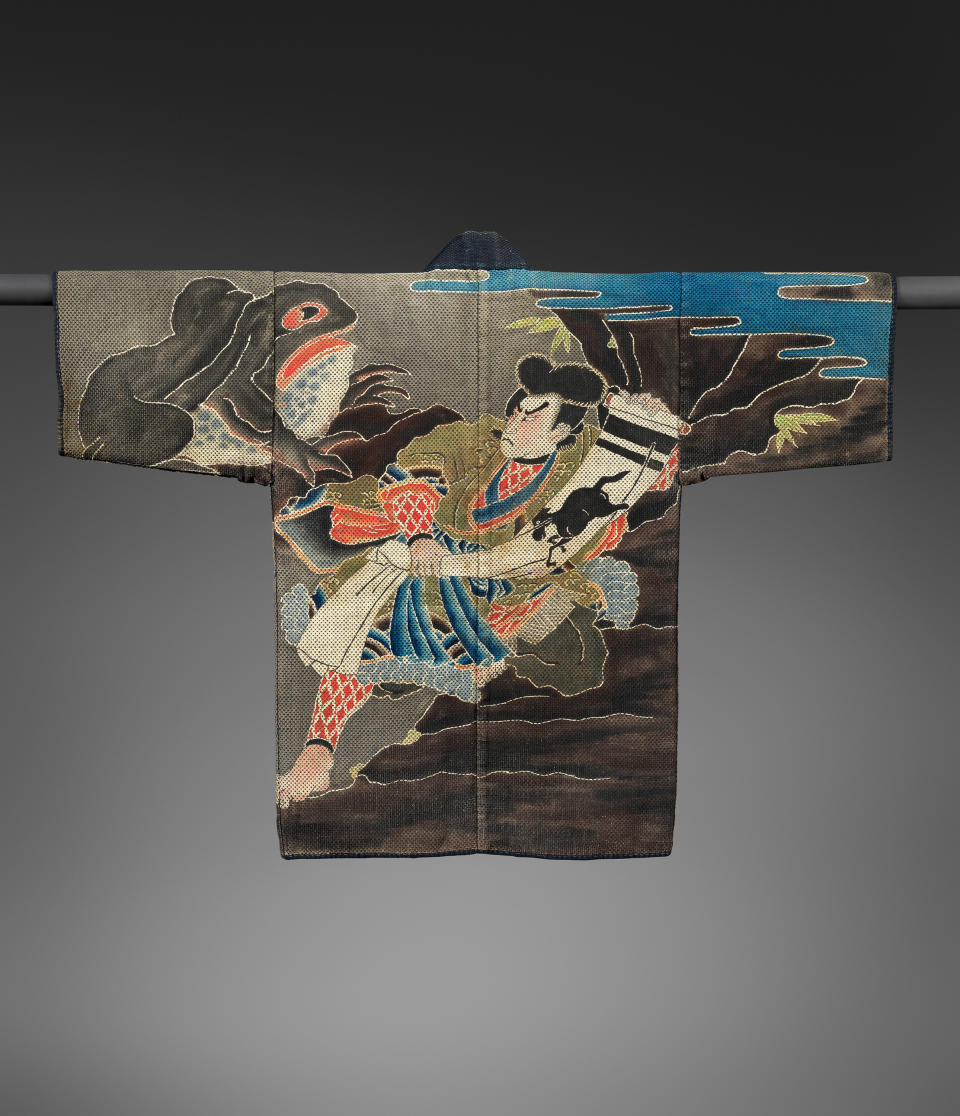
Paul Lachenauer/Courtesy The Metropolitan Museum of Art
In the 1920s, the more attainable “meisen” gained popularity and reflected a more Westernized lifestyle. By the 1920s and 1930s, working-class and middle-class shoppers could find meisens in department stores like Mitsukoshi Department Store that were inspired by the West. One of the more vibrant examples of Western influence is a green and white summer kimono with swirls that magnifies the connection to such avant-garde movements at that time as Art Deco. Another indicator is a meisen kimono with a large checkered pattern from the 1930s that was inspired by Piet Mondrian’s paintings, as seen in the large ikat kimono in bright yellow, teal and raspberry red. “It shows how quickly the Japanese picked up these artistic ideas,” the cocurator said.
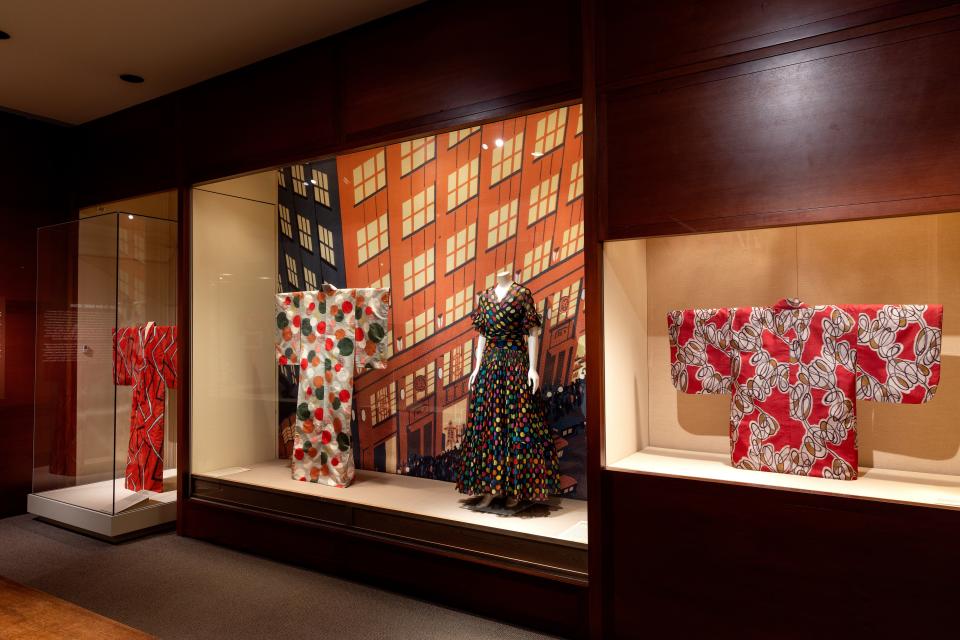
Photo by Bruce Schwarz/Courtesy of The Met
One of the exhibition’s most intriguing pairings is a baby blue kimono-inspired coat that Charles James made for his toddler in 1956 with a child’s kimono with images of Mickey Mouse from the 1930s that borrowed from Walt Disney. “The kimono has a surface that functions as a canvas so you can immediately pick up fashionable designs or new ideas. In Japan, they made kimonos even with trains or planes on them to represent modernity and technical developments.”
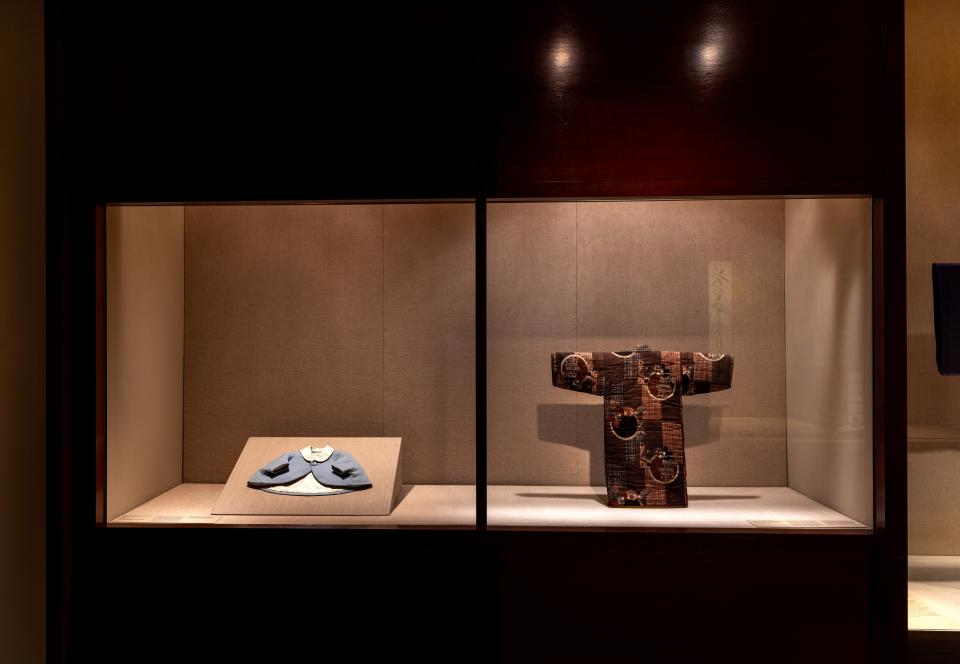
Photo by Barry Schwarz/Courtesy The Met
The sustainability element of fashion is a recurring theme, as kimonos were made from single bolts of fabrics — and in some cases cotton or hemp. When designing with cotton, nothing was to be wasted since it was considered a luxury item at that time. “So they recycled cotton and even cut it up to make a [new] fabric. Back in the day, they were green before we started to think about this issue,” the cocurator said.
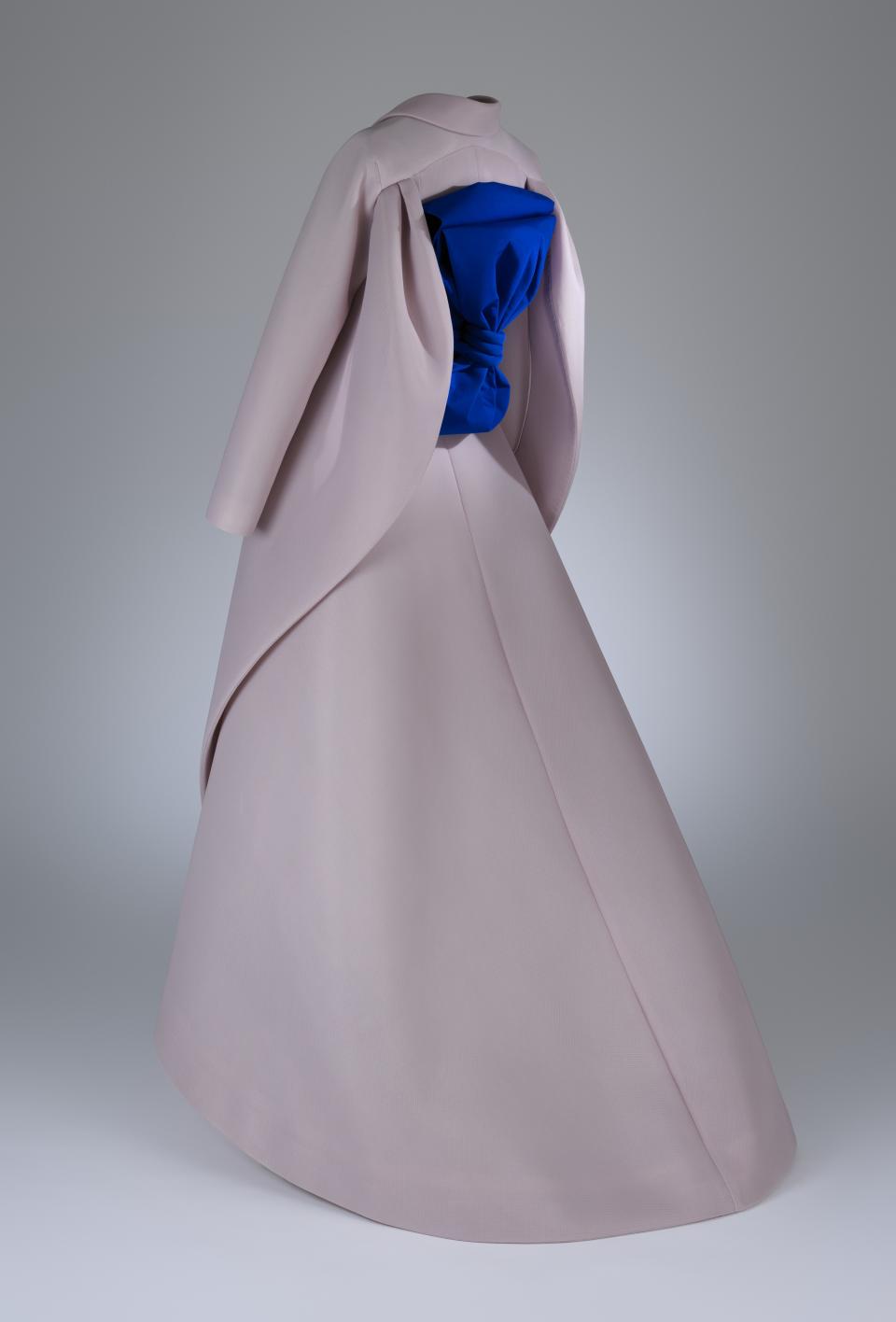
Photo Courtesy Metropolitan Museum of Art
The grand finale, so to speak, has a colorful Comme des Garçons ensemble inspired by the shape and lines of the kimono and has a manga design. Nearby is a dramatic lavender Maison Margiela design by Galliano with a vibrant obi-inspired blue bow on the back and a kimono-inspired collar and sleeves.
Whittling down the selections took some time.
“It was a long, painful process to pick the best ones,” Bincsik said. “But the viewings were fun because we got to look at many of those garments that were inspired by the kimono. I’m hoping that when women walk through, they will discover new ideas about both the kimono and Western fashion.”
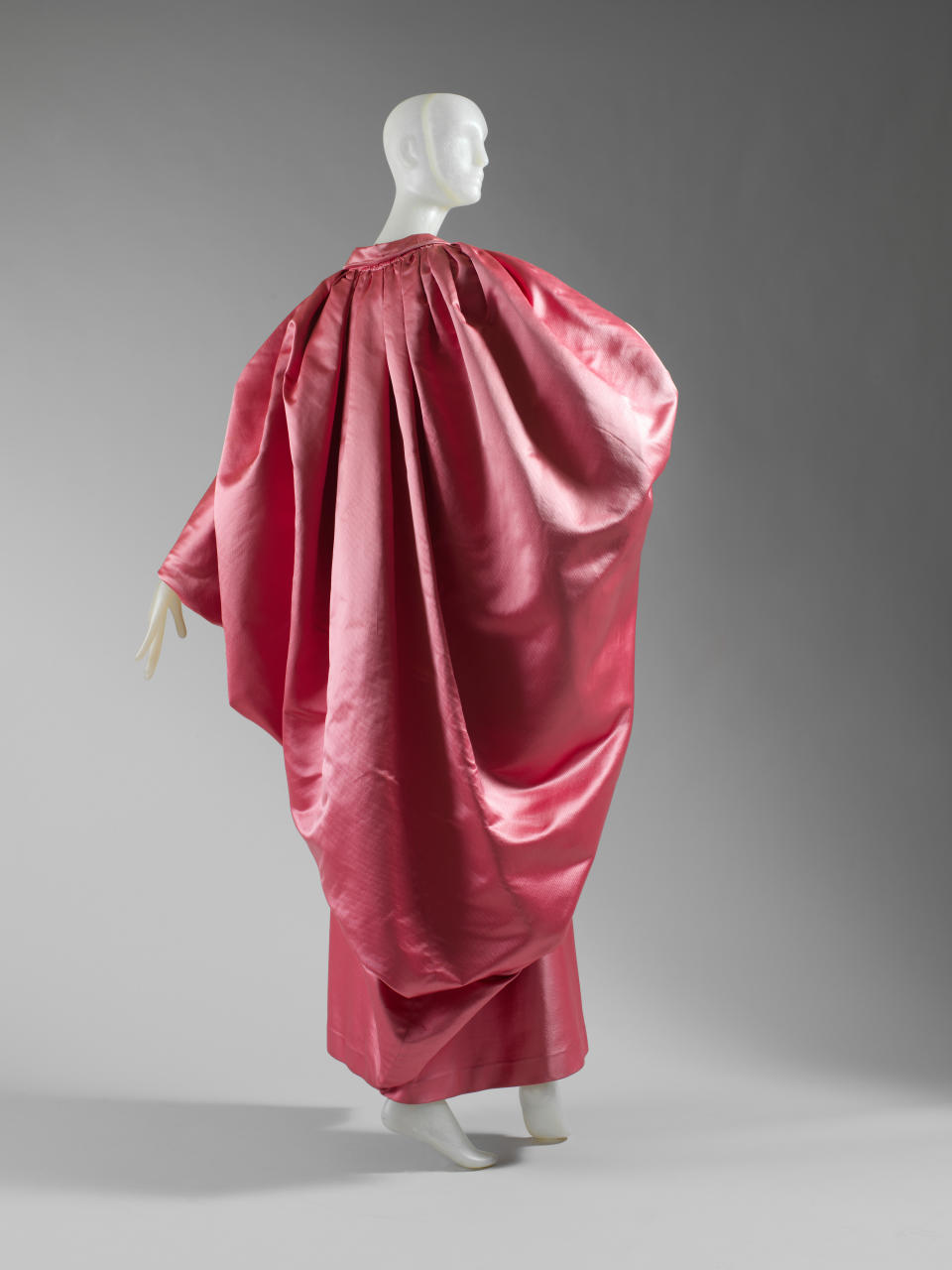
Photo Courtesy The Metropolitan Museum of Art
As for whether the exhibition will have greater impact due to incidents of AAPI-targeted racial crimes in New York City, Bincsik said, “I hope that fashion transcends these conflicts and will also help to send a message about beauty and about how important that [it is] that we don’t think about race and conflicts in the world. But we look at bigger questions like sustainability, the protection of nature and maximize use of fabrics without wasting anything. I hope this will give another perspective of what we encounter these days.”
Best of WWD
Sign up for WWD's Newsletter. For the latest news, follow us on Twitter, Facebook, and Instagram.

